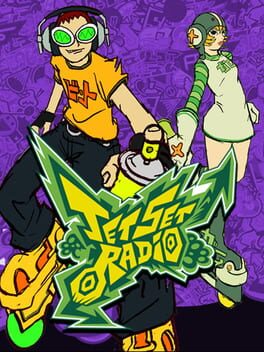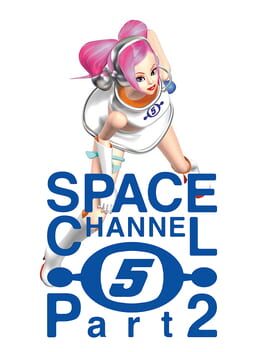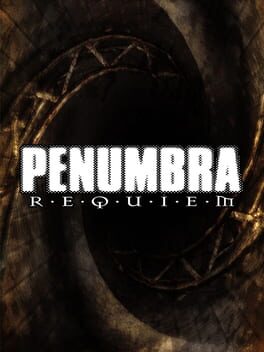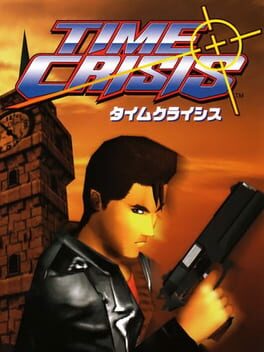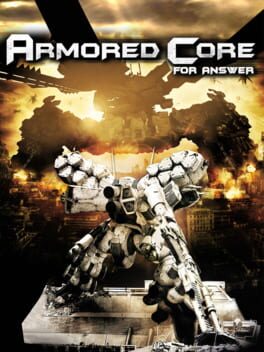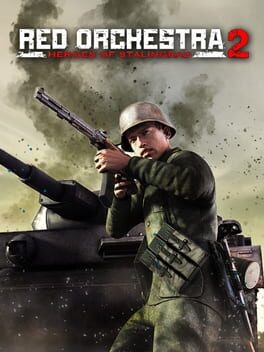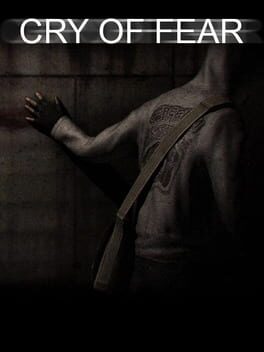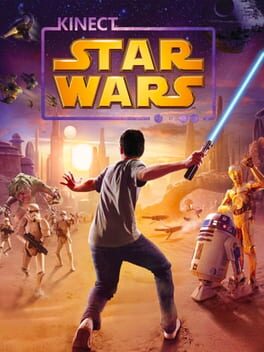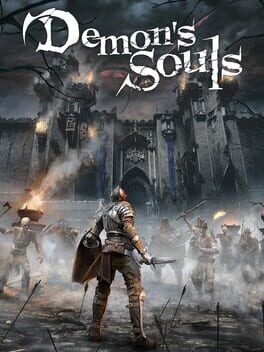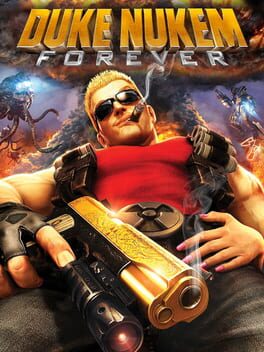facing_w0rlds
238 Reviews liked by facing_w0rlds
IMVU
2004
Californication
2022
i was like 5 years old when i first heard Californication. it made me bug my parents for years to get guitar lessons just to learn how to play it. i kinda did! i recorded a scuffed version of the Can't Stop video with my brother (and a camcorder). the Californication video, at least nowadays, represents to me an idealization of video game aesthetics in a musical dreamscape. music videos of this era tend to be very surreal; the fake game the band was in was just an expression of that trend, but it still easily captured my mind.
the video does not represent a videogame that makes sense. at all. it breaks free from any mechanics and the sense of player input because it's CGI, and it was made with that in mind - not with the intent to create a simulacrum of a videogame. it made me, as a child, go insane about how this music video would work as a real game. even when i was a little kid, it didn't make any sense at all! but it was one of the main things that made me think about how i see games.
yunno, i thought about how those very contextually sensitive animations playing while Flea dodges and jumps around LA people wouldn't make sense in a game played with a controller. "not even GTA can do this!", i thought. that's what made it so dreamlike - the MV emulates videogame aesthetic and UI with graphics that didn't make sense in any console at the time and completely incoherent "gameplay". it's how it feels to dream that you're inside a game.
transforming this into even a slightly playable game, as neat as it is, can't evoke the same feelings that the MV does. the detailed minimap, slightly freeform sections, and the lack of the LA cityscape and iconography make this game too "real". it can't exist. it's based on something that is remarkable specifically because it doesn't exist.
but like, this is still good though. cool effort! just made me think a bit.
the video does not represent a videogame that makes sense. at all. it breaks free from any mechanics and the sense of player input because it's CGI, and it was made with that in mind - not with the intent to create a simulacrum of a videogame. it made me, as a child, go insane about how this music video would work as a real game. even when i was a little kid, it didn't make any sense at all! but it was one of the main things that made me think about how i see games.
yunno, i thought about how those very contextually sensitive animations playing while Flea dodges and jumps around LA people wouldn't make sense in a game played with a controller. "not even GTA can do this!", i thought. that's what made it so dreamlike - the MV emulates videogame aesthetic and UI with graphics that didn't make sense in any console at the time and completely incoherent "gameplay". it's how it feels to dream that you're inside a game.
transforming this into even a slightly playable game, as neat as it is, can't evoke the same feelings that the MV does. the detailed minimap, slightly freeform sections, and the lack of the LA cityscape and iconography make this game too "real". it can't exist. it's based on something that is remarkable specifically because it doesn't exist.
but like, this is still good though. cool effort! just made me think a bit.
Jet Set Radio Future
2002
Jet Set Radio
2012
Space Channel 5
1999
“It’s is very funny to me that your castlevania journey stalled hard on Symphony of the Night, one of the most beloved and influential games of all time.” These words by a close friend of mine have haunted me for months bro.
Classic Ina Followers may recall that last year I spent the month of November playing every Castlevania game in release order, a project that started when I bought that collection of most of the classic games on a whim and sort of just went to town once I realized how entirely my shit every single thing about the series is. Castlevania’s been something of a blindspot for me – as a kid I played AND QUITE LOVED Castlevania 64 and later Order of Ecclesia, and then specifically Lords of Shadow 2, and maybe a couple years ago I had a really great time with Aria of Sorrow but other than futzing around with the first couple of NES games in a false start at this project that was the full extent of my scattered Castlevania experience.
How much I love Aria really set me up for a surprise then because the reason I haven’t posted about Castlevania in a year is that I actually got through like 60 or 70% of this game right after I finished Bloodlines and I was so entirely turned off that I put it down and just didn’t come back for eleven months. I think if I wasn’t so committed to making this a “play every game in the series” kind of thing I may never have.
BUT I DID THIS WEEK and I ZOOMED THROUGH THIS MOTHER FUCKER and I’m SO TORN BRO. Well, not really, I think actually I mostly just don’t like it, but I hope I can adequately explain why.
Because obviously there is so much to love in Symphony, and so much stuff that’s specific to my personal taste too. Aesthetically, the game is a dream, holy SHIT. Everybody knows how good looking it is, experienced sprite artists taking advantage of the fancy new hardware to push what they’re capable of. You see it everywhere, from obvious stuff like Alucard’s butter-smooth animations to the absolutely METICULOUS details in nearly every background in the game, used to dial up a sense of place and atmosphere in as maximal a way as possible but with a slightly different flavor than we got even from powerhouse games like Bloodlines and Super IV. But I don’t just like how GOOD the game looks, I also like how a lot of the time the game looks kind of messy and bad? There are a TON of reused sprites from Bloodlines in this game and listen man I LOVE Bloodlines but it is a stiffer and more early 90s arcadey looking game. It’s that in a way that suits it but compared to the way original sprites look and move in Symphony things just kind of stand out when they’re contrasted. It’s not just that either – the most realistic visual fidelity the series has seen yet along with a much less strong sense of theming than any of its three mainline predecessors (necessitated, I’m sure, by how much exponentially bigger and more open Symphony is) means they really mash ALLLLL the inspirational shit for this series together in a big soup in a way that feels a lot more overt than ever before. You have grotesque horror imagery, fairy tale mystique, hollywood horror guys, and overt cartoon monsters all chilling in this same castle, and often on the same screens as each other, with no sense of visual cohesion tying them together in a way that just didn't come through as hard on, say the NES.
And I think that fucking rips ass dude. I’m sure I’ve spoken about this in these Castlevania writeups before but I think the fact that Symphony of the Night exists so permanently in the cultural memory as this titanic Important Game that people are still playing, especially with its legendary status in the ever-more-popular speedrun world, that it’s easy to forget that it was at one point a game that like, came out, in 1997, in a moment in history. One where 2D games were spoken of by pretty much everyone as if they were relics on their way out the door. That was surely on the minds of the Symphony of the Night team too, who had this game’s obnoxious 3D cutscenes foisted on them by their corporate managers, who were making a game for the Playstation, a console that’s so powerful but also famously kind of bad at running 2D games, who were surely working on this with the understanding that they may not get many more chances to make a game like this, if they got to make any more Castlevanias like this at all.
You can FEEL this energy vibrating through all of Symphony of the Night; it feels like a swan song, a chance to pay homage to everything everyone loved about every single previous iteration of the series and ALSO to cram in every idea they thought might have been cool in this format before the boss came in and started making people learn how to model skeletons riding motorcycles in 3D. SO there’s just all kinds of weird bullshit in here – yeah sure there’s an input based spell system, uhh puzzles will be tied to the game clock, hide a third of the game behind some really oblique bullshit I promise it will be worth it when they figure it out, oh hey what if the game was an RPG and it had the worst menus of all time. Feels like my man Hagihara simply did not say no to anything anyone asked him if they could put in the game and honestly god bless him.
The addition of Ayami Kojima as the key character artist coupled with a returning Michiru Yamane using the strengths of the Playstation's sound doohickeys (idk shit about that stuff man) to deliver something altogether moodier and synthier than we got from previous Castlevanias create the outrageously intense arch-goth style that people identify with this series for the first REAL time I think. There have always been shades of this, it’s a bit hard to avoid when you’re dealing with the subject matter Castlevania does, and the soundtracks have dipped into this vibe from time to time when they’re not fully rocking out but this is a very distinct artistic shift away from both the original 80s hollywood vibes and the more modern anime stylings the series had leaned on up til this point, and I think these aesthetics suit it really well. It looks and sounds like you made a Moto Hagio’s A Drunken Dream get drunk at the kind of nightclub where people still do ecstasy.
It’s so fucking boring though. This is the hardest part for me because ON PAPER Symphony is still theoretically doing the kinds of things that I like to see in exploration based games. The castle is huge but the game leads you directly through very little of it, and there are massive chunks of it that have nothing to do or see in them. So often you’ll work your way through some challenging puzzle room or gauntlet of enemies, maybe even fight a boss, and be rewarded with a swords that’s like fifty times shittier than the knife you’ve been rocking for two hours. That’s fine by me, I do like to get a little treat if it’s gonna be something cool or interesting, but I hate feeling like the only reason to explore in a game is to get to the treasure chest or Lore Nugget or whatever at the end of whatever I’m doing. I rarely feel like Symphony of the Night is doing that though, both because the rewards are genuinely terrible almost every single time (including the important ones! There are SO many upgrades and abilities in this game that are just like complete garbage lmao we are truly filling a list we made the castle so big oh piss oh fuck) but also because almost all of the areas in the game are so distinctly designed and full of personality; I WANT to poke around in them, even if I’m always only doing it to soak up the atmosphere and maybe see what kind of big freak I get to stab at the end.
The big problem for me then is that I think the actual act of moving around the castle feels like complete shit almost all of the time. Not the act of moving Alucard – that feels incredible – but the act of moving inside of the space of the castle. I think something was fumbled pretty badly in the transition from tightly designed levels to a big open world that’s intended to be crossed back and forth over many times. There are certainly a lot of cool rooms that offer neat layouts and challenges to overcome, but SO much of this castle is just big hallways with a few guys copy-pasted in them. It’s not like this didn’t ever happen in Castlevania before, but it was way less common, generally speaking, to see enemies just plopped somewhere without a feeling of intent to where and how they were placed, and I think that almost feels like the MAJORITY of enemies in Symphony of the Night. Space fillers. Overwhelming the player with numbers and leaving it up to me to figure out how to deal with it using his robust arsenal and moveset rather than filling the game with more considered encounters. And I understand how that sounds, for sure; by the sounds of things the game had a rushed development as it is, and I think the piece that we got is pretty astounding considering that, but it doesn’t change tedious it is to just get around. And when there IS a challenge that’s satisfying and tough or even just like difficult and a relief to clear, damn I am usually a lot less enamored with them the third or fourth time I have to truck through that area. The Clock Tower is my arch enemy in this game (I was bad at the switch puzzle).
My other big sticking point is that Castlevania is an RPG now but I think this sucks? I think this sucks dude. I so rarely feel like a proper balance is struck in how this plays out. There’s equipment everywhere and it’s all useless. I like finding the secret abilities, that’s cool, but I am not as crazy about filling my inventory up with fifty shirts that all suck ass. The main issue for me though is the way this affects interacting with enemies, where encounters often boil down to getting turbo stomped and dealing scratch damage based on my level or being able to kill guys by stepping on them – rarely does it feel like I’m properly tuned to stretch my resources from one save point to another.
All of this coalesced on my first playthrough when I got to the upside down castle and found that every enemy suddenly killed me in just a few hits and the nature of the designs of every room meant that while things were somewhat cleverly crafted insofar as the upside down layout accounts for all of your abilities, what that actually means is you have to spend a LOT of time as that awful bat or doing your super jump thing and I really just don’t like how any of the extra traversal stuff in this game feels at all! And that was enough for me to take a break that became a couple weeks that became a couple months that became me restarting the game almost exactly one year later. I did finish it this time, but I find that my feelings haven’t changed very much. I just don’t get along with the part of the game where you’re playing it. Which is, unfortunately, basically all of it.
And yet.
And yet there’s that room with the confessional where you can get the good nice guy who gives you the grape juice or the shitty twisted guy who stabs you, but also you can sit in his chair and a lady will show up and SHE might try to stab you and that is also really cool. You can sit in basically every chair in the game except the one you kill at the end and none of them even do anything, except make you look fucking cool. You can look in that telescope and see the guy in his little boat! If you get some peanuts you throw them into the air and you have to catch them in your mouth to get the health boost because I guess Alucard will only interact with peanuts via fun party tricks. If you have your bat buddy equipped and you turn into your bat form he gets really psyched and then when you turn back into a vampire he’s like damn that sucks. There are seemingly infinite little hidden details and skills and secrets tied to equipment and combinations of equipment and certain inputs and shit. Is that the fucking guy from Kid Dracula? I think it is the fucking guy from Kid Dracula. There are so many greebly little details stuffed into this game for seemingly no reason at all other than that it would be cool to have them in there, and it’s truly impossible not to be charmed by them.
I’m similarly charmed by the story, as scant as it is. I think the character sketches here are strong, and while Maria is pretty swagless here these are the coolest takes on Death and Dracula so far easily. I even think the localization is good, like sincerely I think this is a very fun script with a strong sense of character that matches the tone of the rest of the game. Some of the voice actors are certainly weak links but you’re not gonna catch me saying SHIT about the guy doing Dracula here he is fucking EATING. I think the only time I actually laughed because the game caught me on something silly was when Alucard hit us with that fake Edmund Burke quote in the ending; I guess whatever else he was up to in his exile, Alucard was making sure to keep up with 1700s British politics.
I hope that when I get some more distance from Symphony of the Night that’s the stuff that stands out to me. The verve and playfulness on display here; the expansive lineup of Guys, the beautiful background art. I worry that it will be the bad vibes, which I tried my best to resist. I wanted to like this game more than I did but at some point I had to give up the goat and admit to myself that this was the first time I had ever just really wished I wasn’t playing the game while I was in the middle of it. I know a lot of the big players on this team will go on the be involved in like fifty more games iterating on the foundation laid here, and I know for a fact that I really love at least one of them, so I do hope this one’s a fluke. But even if Symphony is a personal low point for me, that’s like, that’s pretty good right? I guess if this is how I’m feeling about one of the most beloved and influential games of all time then we’re in a pretty good spot, right? Only up from here I’m sure.
NEXT TIME: CASTLEVANIA LEGENDS
LAST TIME: BLOODLINES
Classic Ina Followers may recall that last year I spent the month of November playing every Castlevania game in release order, a project that started when I bought that collection of most of the classic games on a whim and sort of just went to town once I realized how entirely my shit every single thing about the series is. Castlevania’s been something of a blindspot for me – as a kid I played AND QUITE LOVED Castlevania 64 and later Order of Ecclesia, and then specifically Lords of Shadow 2, and maybe a couple years ago I had a really great time with Aria of Sorrow but other than futzing around with the first couple of NES games in a false start at this project that was the full extent of my scattered Castlevania experience.
How much I love Aria really set me up for a surprise then because the reason I haven’t posted about Castlevania in a year is that I actually got through like 60 or 70% of this game right after I finished Bloodlines and I was so entirely turned off that I put it down and just didn’t come back for eleven months. I think if I wasn’t so committed to making this a “play every game in the series” kind of thing I may never have.
BUT I DID THIS WEEK and I ZOOMED THROUGH THIS MOTHER FUCKER and I’m SO TORN BRO. Well, not really, I think actually I mostly just don’t like it, but I hope I can adequately explain why.
Because obviously there is so much to love in Symphony, and so much stuff that’s specific to my personal taste too. Aesthetically, the game is a dream, holy SHIT. Everybody knows how good looking it is, experienced sprite artists taking advantage of the fancy new hardware to push what they’re capable of. You see it everywhere, from obvious stuff like Alucard’s butter-smooth animations to the absolutely METICULOUS details in nearly every background in the game, used to dial up a sense of place and atmosphere in as maximal a way as possible but with a slightly different flavor than we got even from powerhouse games like Bloodlines and Super IV. But I don’t just like how GOOD the game looks, I also like how a lot of the time the game looks kind of messy and bad? There are a TON of reused sprites from Bloodlines in this game and listen man I LOVE Bloodlines but it is a stiffer and more early 90s arcadey looking game. It’s that in a way that suits it but compared to the way original sprites look and move in Symphony things just kind of stand out when they’re contrasted. It’s not just that either – the most realistic visual fidelity the series has seen yet along with a much less strong sense of theming than any of its three mainline predecessors (necessitated, I’m sure, by how much exponentially bigger and more open Symphony is) means they really mash ALLLLL the inspirational shit for this series together in a big soup in a way that feels a lot more overt than ever before. You have grotesque horror imagery, fairy tale mystique, hollywood horror guys, and overt cartoon monsters all chilling in this same castle, and often on the same screens as each other, with no sense of visual cohesion tying them together in a way that just didn't come through as hard on, say the NES.
And I think that fucking rips ass dude. I’m sure I’ve spoken about this in these Castlevania writeups before but I think the fact that Symphony of the Night exists so permanently in the cultural memory as this titanic Important Game that people are still playing, especially with its legendary status in the ever-more-popular speedrun world, that it’s easy to forget that it was at one point a game that like, came out, in 1997, in a moment in history. One where 2D games were spoken of by pretty much everyone as if they were relics on their way out the door. That was surely on the minds of the Symphony of the Night team too, who had this game’s obnoxious 3D cutscenes foisted on them by their corporate managers, who were making a game for the Playstation, a console that’s so powerful but also famously kind of bad at running 2D games, who were surely working on this with the understanding that they may not get many more chances to make a game like this, if they got to make any more Castlevanias like this at all.
You can FEEL this energy vibrating through all of Symphony of the Night; it feels like a swan song, a chance to pay homage to everything everyone loved about every single previous iteration of the series and ALSO to cram in every idea they thought might have been cool in this format before the boss came in and started making people learn how to model skeletons riding motorcycles in 3D. SO there’s just all kinds of weird bullshit in here – yeah sure there’s an input based spell system, uhh puzzles will be tied to the game clock, hide a third of the game behind some really oblique bullshit I promise it will be worth it when they figure it out, oh hey what if the game was an RPG and it had the worst menus of all time. Feels like my man Hagihara simply did not say no to anything anyone asked him if they could put in the game and honestly god bless him.
The addition of Ayami Kojima as the key character artist coupled with a returning Michiru Yamane using the strengths of the Playstation's sound doohickeys (idk shit about that stuff man) to deliver something altogether moodier and synthier than we got from previous Castlevanias create the outrageously intense arch-goth style that people identify with this series for the first REAL time I think. There have always been shades of this, it’s a bit hard to avoid when you’re dealing with the subject matter Castlevania does, and the soundtracks have dipped into this vibe from time to time when they’re not fully rocking out but this is a very distinct artistic shift away from both the original 80s hollywood vibes and the more modern anime stylings the series had leaned on up til this point, and I think these aesthetics suit it really well. It looks and sounds like you made a Moto Hagio’s A Drunken Dream get drunk at the kind of nightclub where people still do ecstasy.
It’s so fucking boring though. This is the hardest part for me because ON PAPER Symphony is still theoretically doing the kinds of things that I like to see in exploration based games. The castle is huge but the game leads you directly through very little of it, and there are massive chunks of it that have nothing to do or see in them. So often you’ll work your way through some challenging puzzle room or gauntlet of enemies, maybe even fight a boss, and be rewarded with a swords that’s like fifty times shittier than the knife you’ve been rocking for two hours. That’s fine by me, I do like to get a little treat if it’s gonna be something cool or interesting, but I hate feeling like the only reason to explore in a game is to get to the treasure chest or Lore Nugget or whatever at the end of whatever I’m doing. I rarely feel like Symphony of the Night is doing that though, both because the rewards are genuinely terrible almost every single time (including the important ones! There are SO many upgrades and abilities in this game that are just like complete garbage lmao we are truly filling a list we made the castle so big oh piss oh fuck) but also because almost all of the areas in the game are so distinctly designed and full of personality; I WANT to poke around in them, even if I’m always only doing it to soak up the atmosphere and maybe see what kind of big freak I get to stab at the end.
The big problem for me then is that I think the actual act of moving around the castle feels like complete shit almost all of the time. Not the act of moving Alucard – that feels incredible – but the act of moving inside of the space of the castle. I think something was fumbled pretty badly in the transition from tightly designed levels to a big open world that’s intended to be crossed back and forth over many times. There are certainly a lot of cool rooms that offer neat layouts and challenges to overcome, but SO much of this castle is just big hallways with a few guys copy-pasted in them. It’s not like this didn’t ever happen in Castlevania before, but it was way less common, generally speaking, to see enemies just plopped somewhere without a feeling of intent to where and how they were placed, and I think that almost feels like the MAJORITY of enemies in Symphony of the Night. Space fillers. Overwhelming the player with numbers and leaving it up to me to figure out how to deal with it using his robust arsenal and moveset rather than filling the game with more considered encounters. And I understand how that sounds, for sure; by the sounds of things the game had a rushed development as it is, and I think the piece that we got is pretty astounding considering that, but it doesn’t change tedious it is to just get around. And when there IS a challenge that’s satisfying and tough or even just like difficult and a relief to clear, damn I am usually a lot less enamored with them the third or fourth time I have to truck through that area. The Clock Tower is my arch enemy in this game (I was bad at the switch puzzle).
My other big sticking point is that Castlevania is an RPG now but I think this sucks? I think this sucks dude. I so rarely feel like a proper balance is struck in how this plays out. There’s equipment everywhere and it’s all useless. I like finding the secret abilities, that’s cool, but I am not as crazy about filling my inventory up with fifty shirts that all suck ass. The main issue for me though is the way this affects interacting with enemies, where encounters often boil down to getting turbo stomped and dealing scratch damage based on my level or being able to kill guys by stepping on them – rarely does it feel like I’m properly tuned to stretch my resources from one save point to another.
All of this coalesced on my first playthrough when I got to the upside down castle and found that every enemy suddenly killed me in just a few hits and the nature of the designs of every room meant that while things were somewhat cleverly crafted insofar as the upside down layout accounts for all of your abilities, what that actually means is you have to spend a LOT of time as that awful bat or doing your super jump thing and I really just don’t like how any of the extra traversal stuff in this game feels at all! And that was enough for me to take a break that became a couple weeks that became a couple months that became me restarting the game almost exactly one year later. I did finish it this time, but I find that my feelings haven’t changed very much. I just don’t get along with the part of the game where you’re playing it. Which is, unfortunately, basically all of it.
And yet.
And yet there’s that room with the confessional where you can get the good nice guy who gives you the grape juice or the shitty twisted guy who stabs you, but also you can sit in his chair and a lady will show up and SHE might try to stab you and that is also really cool. You can sit in basically every chair in the game except the one you kill at the end and none of them even do anything, except make you look fucking cool. You can look in that telescope and see the guy in his little boat! If you get some peanuts you throw them into the air and you have to catch them in your mouth to get the health boost because I guess Alucard will only interact with peanuts via fun party tricks. If you have your bat buddy equipped and you turn into your bat form he gets really psyched and then when you turn back into a vampire he’s like damn that sucks. There are seemingly infinite little hidden details and skills and secrets tied to equipment and combinations of equipment and certain inputs and shit. Is that the fucking guy from Kid Dracula? I think it is the fucking guy from Kid Dracula. There are so many greebly little details stuffed into this game for seemingly no reason at all other than that it would be cool to have them in there, and it’s truly impossible not to be charmed by them.
I’m similarly charmed by the story, as scant as it is. I think the character sketches here are strong, and while Maria is pretty swagless here these are the coolest takes on Death and Dracula so far easily. I even think the localization is good, like sincerely I think this is a very fun script with a strong sense of character that matches the tone of the rest of the game. Some of the voice actors are certainly weak links but you’re not gonna catch me saying SHIT about the guy doing Dracula here he is fucking EATING. I think the only time I actually laughed because the game caught me on something silly was when Alucard hit us with that fake Edmund Burke quote in the ending; I guess whatever else he was up to in his exile, Alucard was making sure to keep up with 1700s British politics.
I hope that when I get some more distance from Symphony of the Night that’s the stuff that stands out to me. The verve and playfulness on display here; the expansive lineup of Guys, the beautiful background art. I worry that it will be the bad vibes, which I tried my best to resist. I wanted to like this game more than I did but at some point I had to give up the goat and admit to myself that this was the first time I had ever just really wished I wasn’t playing the game while I was in the middle of it. I know a lot of the big players on this team will go on the be involved in like fifty more games iterating on the foundation laid here, and I know for a fact that I really love at least one of them, so I do hope this one’s a fluke. But even if Symphony is a personal low point for me, that’s like, that’s pretty good right? I guess if this is how I’m feeling about one of the most beloved and influential games of all time then we’re in a pretty good spot, right? Only up from here I’m sure.
NEXT TIME: CASTLEVANIA LEGENDS
LAST TIME: BLOODLINES
Penumbra: Requiem
2008
Requiem, for reasons that are mostly unfortunate, takes the place of being the worst entry in the Penumbra series with its surprising distancing from its survival horror format and, for whatever reason, turning into a mediocre puzzle-platformer with controls that were certainly not meant for the genre.
As many people familiar with the series know, it was planned to be an entire trilogy, where Overture and Black Plague would serve as the first and second entries. However, dissonance with the publisher stopped that from happening and urged Frictional to tie up loose ends on the story with this pretty weak-willed expansion for BP.
For some reason, they decided to drop the really solid survival horror that made Black Plague a really fun time and just completely shifted to puzzles for the whole time, and not just the “where’s the key hidden” fare that the game usually hangs with. The game sometimes plays like a really shoddy attempt at capturing the cold and hostile serenity underlined with logic puzzles that made the first Portal game so great. There’s a lot of platforming in some of these puzzles, and trust me, the game was DEFINITELY not meant for platforming, as jumping from lift to lift sometimes feels like a diceroll’s chance rather than determined by your own skill. It really sucks when some of the puzzles are halfway decent, because next thing they’re hitting you with the most random reference to the Donkey Kong arcade game in the form of a platforming challenge, and dear god it does not work in the slightest, with not only the puzzle itself sucking but the music randomly taking a chiptune feel, which was so random and offputting.
Even though the ending was pretty bad, I didn't mind the "story" that was at hand, and the couple times they do comic relief with the centre announcer saying out-of-character things really worked for me.
On the bright side, I’m glad that Frictional got to kick off the Amnesia series after this (and to great success/popularity), because in many ways, the first game is essentially the Penumbra 3 that never happened; There’s a big overlap in tone, mechanics, and level design, and even when I don’t completely buy the hype and praise for TDD, I’m glad it really kickstarted Frictional’s popularity.
Hopefully I’ll look into Penumbra: Necrologue soon, which is a total conversion mod for Amnesia that basically turns it back into Penumbra with all the same mechanics, in the form of a continuation of the story.
As many people familiar with the series know, it was planned to be an entire trilogy, where Overture and Black Plague would serve as the first and second entries. However, dissonance with the publisher stopped that from happening and urged Frictional to tie up loose ends on the story with this pretty weak-willed expansion for BP.
For some reason, they decided to drop the really solid survival horror that made Black Plague a really fun time and just completely shifted to puzzles for the whole time, and not just the “where’s the key hidden” fare that the game usually hangs with. The game sometimes plays like a really shoddy attempt at capturing the cold and hostile serenity underlined with logic puzzles that made the first Portal game so great. There’s a lot of platforming in some of these puzzles, and trust me, the game was DEFINITELY not meant for platforming, as jumping from lift to lift sometimes feels like a diceroll’s chance rather than determined by your own skill. It really sucks when some of the puzzles are halfway decent, because next thing they’re hitting you with the most random reference to the Donkey Kong arcade game in the form of a platforming challenge, and dear god it does not work in the slightest, with not only the puzzle itself sucking but the music randomly taking a chiptune feel, which was so random and offputting.
Even though the ending was pretty bad, I didn't mind the "story" that was at hand, and the couple times they do comic relief with the centre announcer saying out-of-character things really worked for me.
On the bright side, I’m glad that Frictional got to kick off the Amnesia series after this (and to great success/popularity), because in many ways, the first game is essentially the Penumbra 3 that never happened; There’s a big overlap in tone, mechanics, and level design, and even when I don’t completely buy the hype and praise for TDD, I’m glad it really kickstarted Frictional’s popularity.
Hopefully I’ll look into Penumbra: Necrologue soon, which is a total conversion mod for Amnesia that basically turns it back into Penumbra with all the same mechanics, in the form of a continuation of the story.
Time Crisis
1995
Despite my obsession with Time Crisis, the original game is something that I respect a lot more than I actually enjoy playing. Right away, the hallmarks that characterize the series are present front and center. The trademark cover system becomes key to careful resource management, in that you must time your dodges carefully against incoming attacks while keeping an eye on your remaining ammo and syncing your dodges with necessary reloads. Enemies are color-coded to quickly communicate their threat level (reds will almost immediately damage you, orange vests have trickier weapons with slower attacks but higher accuracy, and blues are your standard fare that tend to shoot like stormtroopers but will eventually find you), with closer enemies easier to spot and hit but generally posing a larger threat, especially enemies with clubs and claws that will never miss. Headshots aren’t required since any hit will immediately down a foe, but higher accuracy is nevertheless rewarded because enemies are often utilizing cover just like you, and nailing enemies when they’re appearing for the first time out of hidden traps and doors or hitting their exposed limbs sticking out of cover saves valuable seconds.
As such, the toughest enemy is not so much Time Crisis’ many goons or the bosses, but rather, the timer itself. It’s simultaneously the original Time Crisis’ biggest draw and biggest con: every action you take contributes to preservation of your remaining time, including optional bright orange enemies that provide little time bonuses upon hit, resulting in a very focused arcade experience. However, as a result, I found the game to be extremely difficult and punishing: you can’t afford to play it safe with the scant time gains you’ll get from clearing each scenario (since the timer is never reset, even after clearing acts or stages), especially because enemies appear in waves that progress only upon clearing all present enemies on screen, and can also waste tons of time if you miss and they duck behind cover. This wouldn’t be as much of a problem, except unlike the other main installments, standard enemies (blues and more competent browns) in the original Time Crisis deal damage based off of bullet thresholds; after a certain number of shots fired your way out of cover, they sometimes have a chance to fire a shot that can actually damage you. There’s no feasible way to distinguish between a shot from these foes that will miss versus actually hitting you, because the animation to duck below cover isn’t faster than the short delay between the red flash of damaging bullets and the actual hit, so it’s impossible to react to. Furthermore, actually getting hit wastes a few seconds because it puts you in a state where you cannot fire or duck below cover to reload, creating further complications especially in scenarios where multiple enemies are on screen firing at you. As a result, it often felt like I was required to memorize spawn locations and pick off enemies immediately to prevent most bullets from being fired altogether, since playing by quick reaction felt unviable when I had to play proactively in scenes where multiple enemies were firing, making it easy to lose track of how many bullets came close to hitting me. This pressure of needing to play almost perfectly was exacerbated by the fact that continues restart you at the beginning of acts instead of resuming where you lost all your lives, and that there is no way to regain lives outside of downing 40 enemies in a row without missing once. I respect what the original was trying to do with its simple toolkit and scoring system, but I can’t deny that the difficulty curve felt ridiculously steep and unwelcoming at times.
Still, I can’t be too much of a downer. It’s classic Time Crisis with a batshit crazy plot involving destructive weapons, kidnapping, and terrorists, alongside extremely cheesy dialogue and corny voice-acting with tons of flashy boss fights in a 3D low-polygonal trap-ridden castle. The exclusive Special Mode in the Playstation edition is a nice cherry on top, with branching paths that decide what environments you traverse resulting in different boss fights, all determined based upon your clear times: not quite as exciting as how they handle branching paths in House of the Dead (i.e. saving civilians, shooting switches, etc), but I respect its presence regardless. While I’ll generally deviate towards the other entries in the series, I’m glad I got to finally explore the ambitious beginnings of my favorite light-gun franchise that set the standard of spectacle for future installments. Now if only I could find those remaining Time Crisis II and 4 cabinets…
As such, the toughest enemy is not so much Time Crisis’ many goons or the bosses, but rather, the timer itself. It’s simultaneously the original Time Crisis’ biggest draw and biggest con: every action you take contributes to preservation of your remaining time, including optional bright orange enemies that provide little time bonuses upon hit, resulting in a very focused arcade experience. However, as a result, I found the game to be extremely difficult and punishing: you can’t afford to play it safe with the scant time gains you’ll get from clearing each scenario (since the timer is never reset, even after clearing acts or stages), especially because enemies appear in waves that progress only upon clearing all present enemies on screen, and can also waste tons of time if you miss and they duck behind cover. This wouldn’t be as much of a problem, except unlike the other main installments, standard enemies (blues and more competent browns) in the original Time Crisis deal damage based off of bullet thresholds; after a certain number of shots fired your way out of cover, they sometimes have a chance to fire a shot that can actually damage you. There’s no feasible way to distinguish between a shot from these foes that will miss versus actually hitting you, because the animation to duck below cover isn’t faster than the short delay between the red flash of damaging bullets and the actual hit, so it’s impossible to react to. Furthermore, actually getting hit wastes a few seconds because it puts you in a state where you cannot fire or duck below cover to reload, creating further complications especially in scenarios where multiple enemies are on screen firing at you. As a result, it often felt like I was required to memorize spawn locations and pick off enemies immediately to prevent most bullets from being fired altogether, since playing by quick reaction felt unviable when I had to play proactively in scenes where multiple enemies were firing, making it easy to lose track of how many bullets came close to hitting me. This pressure of needing to play almost perfectly was exacerbated by the fact that continues restart you at the beginning of acts instead of resuming where you lost all your lives, and that there is no way to regain lives outside of downing 40 enemies in a row without missing once. I respect what the original was trying to do with its simple toolkit and scoring system, but I can’t deny that the difficulty curve felt ridiculously steep and unwelcoming at times.
Still, I can’t be too much of a downer. It’s classic Time Crisis with a batshit crazy plot involving destructive weapons, kidnapping, and terrorists, alongside extremely cheesy dialogue and corny voice-acting with tons of flashy boss fights in a 3D low-polygonal trap-ridden castle. The exclusive Special Mode in the Playstation edition is a nice cherry on top, with branching paths that decide what environments you traverse resulting in different boss fights, all determined based upon your clear times: not quite as exciting as how they handle branching paths in House of the Dead (i.e. saving civilians, shooting switches, etc), but I respect its presence regardless. While I’ll generally deviate towards the other entries in the series, I’m glad I got to finally explore the ambitious beginnings of my favorite light-gun franchise that set the standard of spectacle for future installments. Now if only I could find those remaining Time Crisis II and 4 cabinets…
Cry of Fear
2013
The first half of Cry of Fear delivers a top tier horror experience. Its claustrophobic environments create a sense of unease and the deliberately janky combat amplifies the tension. The light puzzles help it maintain a well-paced flow, preventing any sense of monotony.
But then, Chapter 4 hits and I go : https://www.youtube.com/watch?v=dsV7JoDPajU
It takes an unexpected turn into an uninspiring fetch quest with a more action-oriented approach. This slight shift in gameplay in increaseing enemy spawn rate in more open areas, doesn't quite align with the game's Silent Hill-esque combat. Moreover, the iconic Half-Life 1 jank become more unbearable during platforming and nightmare sections, making me a lot more grateful for Valve's inclusion of quicksaves in all their singleplayer games.
As for the story, it's alright. Although, like with some other indie horror games, I can't help but evoke the thought, 'this is just doing what Silent Hill 2 did way better.' But it's worth noting that Cry of Fear was developed by a group of college boys, not a team of AAA professionals. The game radiates a genuine sense of passion and commitment and the flaws don't overshadow the effort and dedication poured into creating it.
It has heart, a somewhat janky heart, but it is still in the right place.
But then, Chapter 4 hits and I go : https://www.youtube.com/watch?v=dsV7JoDPajU
It takes an unexpected turn into an uninspiring fetch quest with a more action-oriented approach. This slight shift in gameplay in increaseing enemy spawn rate in more open areas, doesn't quite align with the game's Silent Hill-esque combat. Moreover, the iconic Half-Life 1 jank become more unbearable during platforming and nightmare sections, making me a lot more grateful for Valve's inclusion of quicksaves in all their singleplayer games.
As for the story, it's alright. Although, like with some other indie horror games, I can't help but evoke the thought, 'this is just doing what Silent Hill 2 did way better.' But it's worth noting that Cry of Fear was developed by a group of college boys, not a team of AAA professionals. The game radiates a genuine sense of passion and commitment and the flaws don't overshadow the effort and dedication poured into creating it.
It has heart, a somewhat janky heart, but it is still in the right place.
Kinect Star Wars
2012
Demon's Souls
2020
cannot say i am particularly enamored with the idea that we should frame this discussion in any way that pretends it is not ultimately a willful net loss for games preservation. the idea that in order to aggressively push hardware a development team was enlisted to resurrect a long forsaken ip, in the process fundamentally misunderstanding the majority of its artistic sensibilities (sometimes aggressively so) to showcase a console’s power rubs me the wrong way for several reasons. and there’s potent irony here because we must also remember that in essence sony is banking on from softwares death cult to launch a console cycle for the second time in a row now. recall the invective words of shuhei yoshida, 2009: 'This is crap. This is an unbelievably bad game.' surely what is now a valuable ace in the sleeve for sonys financial strategy in the 9th generation of consoles onwards deserves more respect than this?
as an immediate contrast in the field of remakes, i’ll put forward that at the very least, ff7 is one of the most ubiquitous games of all time - to such a degree that altering its content and expanding on its themes in a rebuild-esque scenario is not only sensible, but appreciated. the same case is difficult to make for demon’s in my opinion.
perhaps bluepoints alterations, seldom rooted in any reverence for aesthetics but instead prioritizing largely perfunctory gameplay, are to your tastes. but they are not to mine. the original demon’s souls is an intensely difficult work to assess, litigate, and reconcile with, to be sure, but whatever your stance on it, it’s difficult to deny how exquisitely it worked with its limitations to fashion something that was entirely inspired and bold, yet quintessentially from software. none of that same evocative ethos is reflected here, and for these reasons i find bluepoint’s iteration extremely difficult to respect - doubly so because im in a position now of having twice been told to give bluepoint a chance on a remake, both times to personally and deeply unsatisfactory results. i only wish more folks had a convenient way of experiencing the original so they were free to pass their own judgments
as an immediate contrast in the field of remakes, i’ll put forward that at the very least, ff7 is one of the most ubiquitous games of all time - to such a degree that altering its content and expanding on its themes in a rebuild-esque scenario is not only sensible, but appreciated. the same case is difficult to make for demon’s in my opinion.
perhaps bluepoints alterations, seldom rooted in any reverence for aesthetics but instead prioritizing largely perfunctory gameplay, are to your tastes. but they are not to mine. the original demon’s souls is an intensely difficult work to assess, litigate, and reconcile with, to be sure, but whatever your stance on it, it’s difficult to deny how exquisitely it worked with its limitations to fashion something that was entirely inspired and bold, yet quintessentially from software. none of that same evocative ethos is reflected here, and for these reasons i find bluepoint’s iteration extremely difficult to respect - doubly so because im in a position now of having twice been told to give bluepoint a chance on a remake, both times to personally and deeply unsatisfactory results. i only wish more folks had a convenient way of experiencing the original so they were free to pass their own judgments



